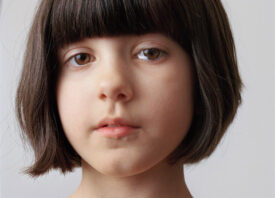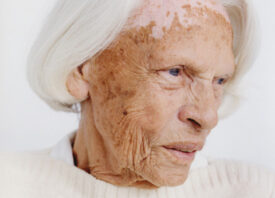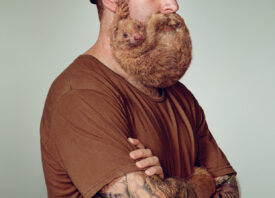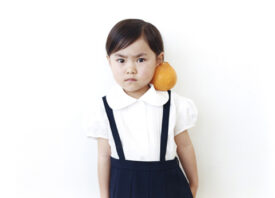Search this site
Powerful Portraits Of Facial Reconstruction Patients
In a series of portraits, the French photographer Cyril Crepin tells the stories of patients undergoing facial reconstructive surgery. With the help of their surgeon, Professor Bernard Devauchelle, the artist set up intimate sessions in the hospital where they were treated. The reasons behind the reconstructions are tragic, ranging from accidents to suicide attempts, but Crepin avoids submitting to voyeurism or sensationalism.
Instead, his portraits ask that we set aside any hesitation we might feel at meeting these people eye-to-eye in favor of recognition, acknowledgment, and ultimately, reverence. As we take in the realities of flesh and wound, we recognize a connective thread, binding us all as mortals–capable of unimaginable agony as well as unfathomable resilience. We asked Crepin a few questions about the project.

What inspired you to pursue this project?
“I was probably tired of seeing the same pictures all the time and hearing the same speech about ‘beauty.’ I always loved painters like Matthias Grünewald, Albrecht Durer, some illustrators like Basil Gogos, some classics movies with Lon Chaney too … the first time I saw one of these models, I though immediately of the ‘Retable d’Issenheim’ [by Matthias Grünewald]; the face of this person looked unreal, and it was amazing. I took many surgical pictures, but it was the first time I was confronted with this vision, and I talked with him, read about his pathology, and we decided to make a picture series about disfigurement, because nobody else in the world did it before in an artistic way, and not from a medical point of view— these are not medical photographs.
“I took them like a fine art project to show to the world the beauty in these faces, to try to change how people see conventional beauty. Today, it looks like our society thinks ‘ultra lifted’ faces are pretty, but they all look the same. Most disfigured people stay hidden. They don’t have any kind of social life because of the looks and the words of ‘normal’ people. It’s a shame. One of my models (who is a friend now) told me that one day when he was in the street, a guy crossed the road in his direction and told him, ‘how can you stay like this? Look at you! If I were you, I’d put a bullet in my head.’ This is the reality for these people. So the minimum we can do is to look these portraits and find a certain kind of beauty in them.”

How did you find your subjects and Professor Bernard Devauchelle?
“My sister Delphine was a surgery nurse, and she worked with Bernard Devauchelle. I came back from the U.S., where I lived for two years, and she told me then the professor was looking for a photographer to take some study portraits. I went to the hospital to see his patient and started to shoot, not like regular medical pictures (I was not interested in this discipline). I showed my pictures to Devauchelle, who liked the result, and we started to talk about a series featuring the worst cases of disfigurement in the world and how I could make them beautiful, not just with a simple image but how I could capture the right moment, the moment in their eyes when you can almost see their souls.”

We place so much emphasis on the human face; in it, we read and evaluate each other’s character and experience, often in prejudiced ways. How do your portraits disrupt these judgements?
“In every picture, the model is looking at you, even when they don’t have any eyes. It might seem weird to say that, but it’s true: my intention is to reverse the roles. When you see them on the wall (the pictures framed are really large), you don’t really feel comfortable because all the disfigured people look at you, all of them, and now you feel like you are not ‘the normal one’ in the exhibition room. I hope make you understand how it is to be seen like a ‘curiosity.’ But if you take the time to look into their eyes, you understand that they are human beings just like you and me. They have feelings too; in some of them you can see distress, happiness, anger… You don’t have to be scared. They are the victims, not you.”

Your portraits are of people whose facial features have been deconstructed and rebuilt. How does this ordeal reshape one’s identity, if it does so at all?
“It’s really complicated. Before all of it [the reconstructions] there are accidents, diseases, aggressions, suicides… And it’s even more complicated when I show some facial transplants. All the people I met were really nice, but [they] don’t forget they still are ill, inside a hospital. They know they probably need to have many surgeries. Some of them know they are dying. Usually I see them one or two times, never more, but it’s enough to be a sort of confidante for them. I don’t wear a surgical gown, so they talk to me like a friend [and can discuss] their suffering; sometimes we even laugh together. When you don’t have anymore or anything to loose you are ‘real’ and ‘true.’ They know they never will be [exactly like] they used to be; they have to change, and they do it in a good way I think.”

What do you hope your subjects feel when they look at your images?
“I hope they are proud of themselves. They give us a lesson in courage.”

You shot these photographs in the hospital where your subjects were treated; in this way, they are beautifully private and intimate. How has the outside world reacted to the work?
“Most people don’t understand it. They keep going to things like ‘P.T Barnum,’ or they look away. They prefer read tabloids or watch children dying on TV (I’m referring to the crisis in Syria) but they are afraid of my pictures, maybe because they know it could happen to anyone. During my last exhibition, the public started to understand and see the beauty in my work, and many magazines all over the world began to write about them. I’m still looking to exhibit in some art galleries, art centers in the U.S., and to collaborate with some artists too, so feel free to contact me.”

Sadly, we live in a world where conventional “beauty” is usually the only thing people find worth photographing. Why is it important that we see images like these?
“It’s important to see these images to understand that you can find beauty everywhere, [a reminder] to stop believing the mass media and acting like sheep, to accept differences, and to see humanity behind suffering. These people exist and have feelings. Talk to them. Don’t look away, but smile. It’s a message of hope for them. I’m not a medical photographer — I’m looking to show another kind of beauty: a powerful image. I want you to put these portraits on your wall, look at them and say: ‘This is fine art.'”









